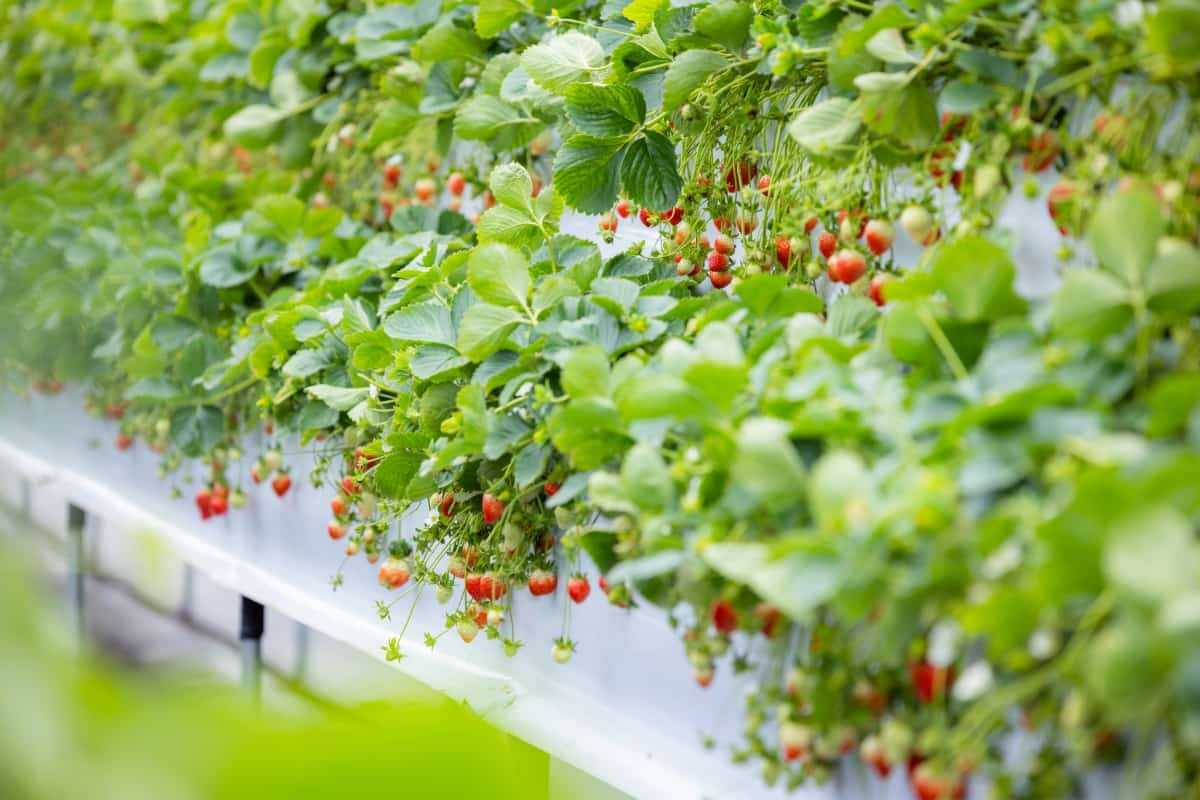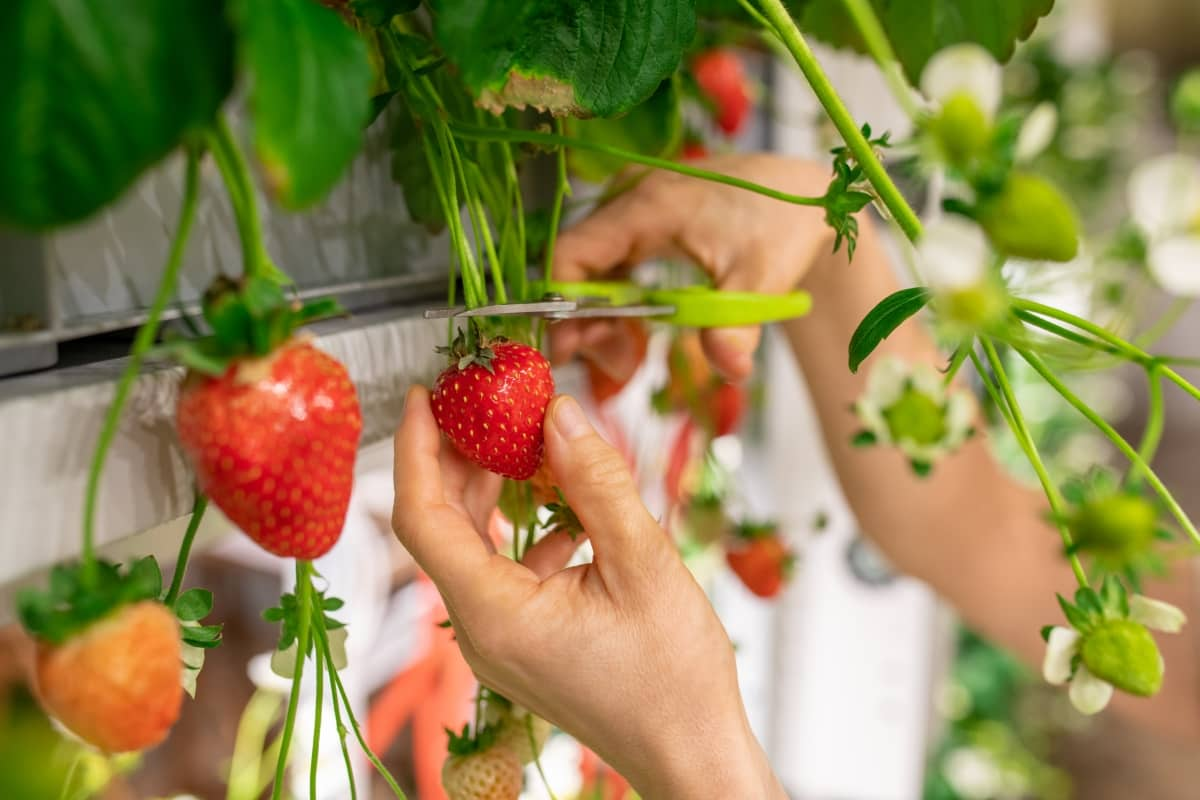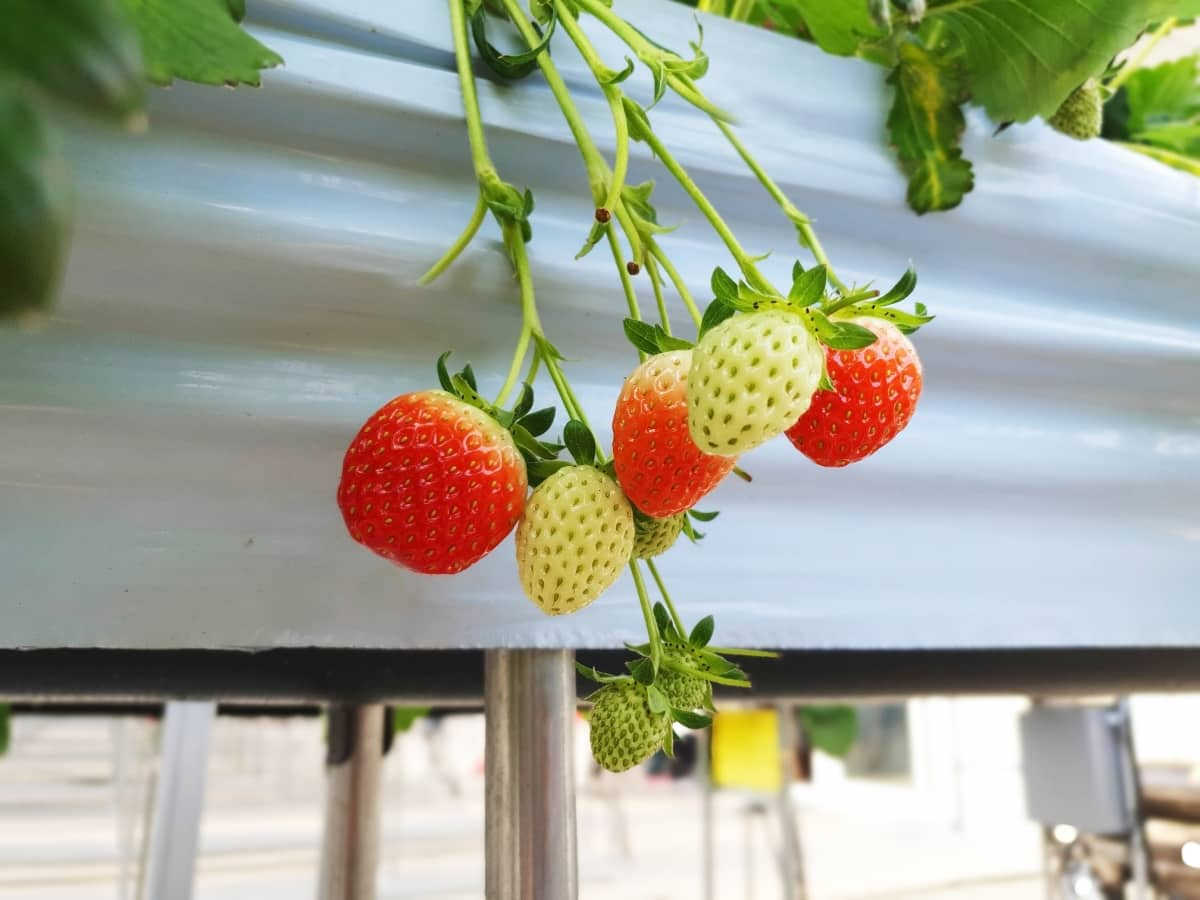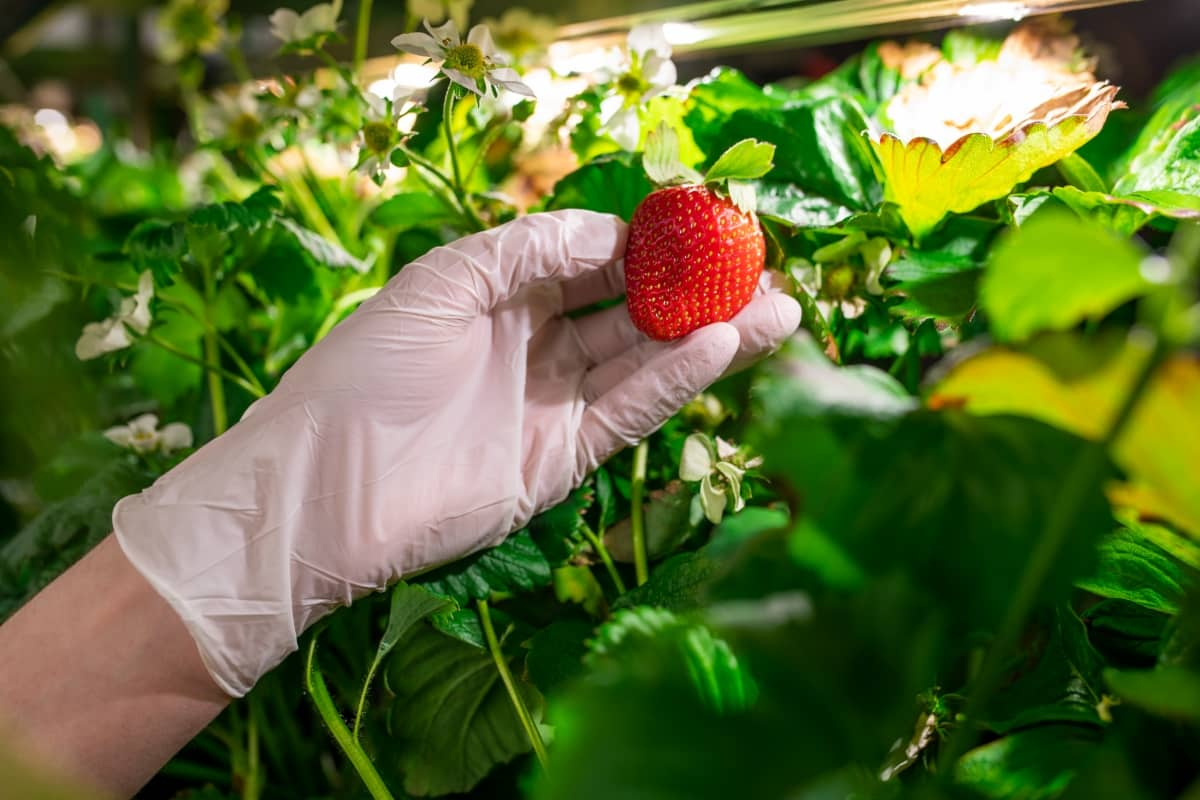Growing strawberries in aquaponics combines aquaculture and hydroponics, creating a symbiotic system where fish waste provides nutrients for the strawberry plants. In this sustainable method, fish waste is converted into nutrient-rich water, fostering optimal strawberry growth. The aquaponic system utilizes less water than traditional methods and eliminates the need for soil.

It maximizes space efficiency, accelerates plant development, and produces both fish and strawberries simultaneously. By promoting a closed-loop ecosystem, aquaponic strawberry cultivation exemplifies an environmentally friendly and resource-efficient approach, offering a flavorful and nutritious harvest while minimizing environmental impact.
Grow Strawberries in Aquaponics
Selecting the Right Aquaponic System for Strawberries Cultivation
For strawberry cultivation in aquaponics, the Nutrient Film Technique (NFT) system is ideal. NFT delivers a thin film of nutrient-rich water to plant roots, promoting optimal growth. Its efficient water use and minimal substrate make it suitable for strawberries. Additionally, pairing it with a media-filled bed for biofiltration enhances nutrient cycling.
The compactness of the system allows for vertical stacking, maximizing space utilization. Ensure proper pH and nutrient balance, maintaining water quality. Overall, the NFT system with a biofilter bed proves advantageous for cultivating strawberries in aquaponics due to its water efficiency, space utilization, and effective nutrient delivery.
Choosing the Best Varieties of Strawberries for Aquaponic Farming
Consider everbearing types, such as Albion or Seascape; they produce fruit throughout the growing season. These varieties adapt well to aquaponic systems, thriving in the nutrient-rich water environment. Another excellent choice is Tristar, known for its high-quality berries and adaptability to various hydroponic setups.
When choosing, prioritize disease resistance and compact growth habits to maximize space efficiency in aquaponic systems. Additionally, varieties like Chandler or Camarosa are popular for their flavor and large fruit size, making them appealing choices for aquaponic farmers aiming for both quality and quantity.
Essential Water Quality Parameters for Strawberries Growth in Aquaponics
For optimal strawberry growth in aquaponics, crucial water quality parameters include pH levels between 5.8 and 6.5, ensuring acidic to slightly acidic conditions. The electrical conductivity (EC) should range from 1.2 to 2.0 mS/cm to provide sufficient nutrient availability.
Maintaining an ammonia level below 0.5 mg/L is vital to prevent toxicity, while nitrate levels between 20 and 150 mg/L support robust plant development. Adequate dissolved oxygen (DO) levels, ideally above 5 mg/L, are crucial for root health. Regular monitoring and adjustment of these parameters contribute to a balanced aquaponic system, fostering optimal conditions for successful strawberry cultivation.
Providing Essential Nutrients for Aquaponic Strawberries
In aquaponic systems for strawberries, ensure proper nutrient balance by incorporating fish waste as a natural fertilizer. Nitrogen-rich waste provides essential nutrients for plant growth. Maintain pH levels between 5.8 and 6.5 for optimal nutrient absorption. Supplement iron, potassium, and calcium as needed, promoting healthy fruit development. Utilize fish species like tilapia, which produce nutrient-dense waste.
In case you missed it: How to Grow Wild/Alpine Strawberry: Planting to Harvest Guide

Monitor water quality regularly to prevent nutrient deficiencies or excesses. Implement a well-balanced aquaponic ecosystem, harmonizing fish, plants, and microbes to foster sustainable and thriving strawberry cultivation. Adjust nutrient levels based on plant growth stages, ensuring a bountiful and nutritious strawberry harvest.
Lighting Requirements for Growing Strawberries in an Aquaponic System
Strawberries thrive in aquaponic systems with 12-16 hours of daily light exposure. Provide full-spectrum LED lights mimicking sunlight, with a color temperature between 5,000-6,500 Kelvin for optimal growth. Mount lights 12-18 inches above plants, adjusting as they grow. Maintain a consistent photoperiod to encourage flowering and fruiting. Adequate lighting promotes photosynthesis, enhancing nutrient absorption from the aquaponic system.
Monitor light intensity, aiming for 200-400 micromoles per square meter per second. Consider natural light supplementation if possible. Regularly assess plant health and adjust lighting accordingly, ensuring a balance for robust strawberry development in the aquaponic environment.
Temperature and Climate Control for Optimal Strawberries Growth
For optimal strawberry growth, maintain a temperature range of 15-24°C during the day and 10-15°C at night. Adequate ventilation is crucial to prevent heat buildup. Humidity levels between 60-80% foster flower and fruit development. Implement a drip irrigation system, delivering consistent moisture while avoiding waterlogged soil. Shield plants from extreme temperatures with row covers or shade cloth. In colder climates, consider high tunnels or greenhouses. Regularly monitor soil moisture, adjusting irrigation accordingly.
Planting and Spacing: Best Practices for Strawberries in Aquaponics
In aquaponics, strawberries thrive when planted in well-aerated media beds with a pH range of 5.8 to 6.5. Ensure a spacing of 8-12 inches between plants to promote adequate air circulation and prevent disease. Plant strawberries at a depth that covers the roots but keeps the crown above the media.
In case you missed it: 8 Common Problems with Garden-Grown Strawberries: How to Overcome Them

Employ a balanced aquaponic nutrient solution, maintaining optimal nitrogen levels. Regularly monitor water temperature and provide adequate support for the growing plants. Implementing these practices will foster healthy strawberry growth, ensuring a productive and flourishing aquaponic system.
Maintenance and Care for Strawberries in Aquaponics
- Ensure pH levels between 5.8 and 6.5 for optimal nutrient absorption. Monitor ammonia and nitrate levels; maintain proper balance.
- Keep the water temperature around 15-24°C. Provide 8-10 hours of sunlight or use grow lights.
- Use a well-draining substrate like coconut coir. Plant strawberries in towers or hanging containers for efficient use of space.
- Utilize a balanced aquaponic nutrient solution. Adjust nutrient levels based on plant growth stages.
- Regularly prune runners to encourage fruit production. Train plants to prevent overcrowding and ensure adequate airflow.
- Monitor for pests like aphids and implement organic controls. Maintain a clean system to prevent diseases; remove infected plants promptly.
When and How to Harvest Strawberries in Aquaponics
Harvest strawberries in aquaponics when they reach full ripeness, typically 4-6 weeks after flowering. Look for a vibrant red color, plumpness, and a sweet aroma. Gently pick the berries, ensuring you don’t damage the delicate plants. Harvesting is often done in the morning when temperatures are cooler. Use clean and sharp scissors to snip the stem just above the fruit. Avoid overharvesting to allow smaller berries to mature. Regularly check for ripe strawberries throughout the growing season, promoting continuous production.
In case you missed it: Project Report of 1-Acre Strawberry Farming: Production Cost and Profit Analysis

Conclusion
By following these steps, you can create a thriving aquaponics system that yields delicious and homegrown strawberries. Enjoy the process of tending to your aquaponic garden and relish the satisfaction of harvesting fresh, flavorful strawberries from your sustainable and eco-friendly setup. Monitor and adjust your system as needed, embracing the dynamic nature of aquaponics to optimize the growth of your strawberry plants. Happy harvesting!
- Feed Your Flock for Less: Top 10 Tips to Save on Chicken Feed
- Ultimate Guide to Ossabaw Island Hog: Breeding, Raising, Diet, and Care
- Hatching Answers: The Top 10 Reasons Your Chickens Aren’t Laying Eggs
- Eggs and Economics: Breaking Down the Cost of Raising Backyard Chickens
- Defend Your Greens: Proven Methods to Keep Iguanas Out of Your Garden
- Ultimate Guide to Cinnamon Queen Chicken: A Comprehensive Guide for Beginners
- Ultimate Guide to California Tan Chicken: Breeding, Raising, Diet, Egg-Production and Care
- Ultimate Guide to Marsh Daisy Chicken: Breeding, Raising, Diet, and Care
- 10 Types of Chicken Farming Businesses You Can Start for Profits